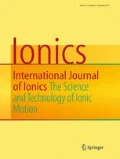Abstract
Improving the safety features of traditional Li-ion batteries having a flammable liquid electrolyte is one of the current challenges that scientists have been trying to overcome. Inorganic solid ionic conductors are promising option to replace the liquid electrolytes in Li-ion batteries because of their high temperature stability. But their poor ionic conductivity is one bottleneck that prevents them in a widespread use. In order to increase the ion conduction, the electrolytes should be as dense as possible since pores have no contribution to ionic conductivity. For densification assessments during sintering of Li7La3Zr2O12, one of the popular inorganic solid ion conductors in the field of all solid-state Li-ion batteries, the Archimedes density measurement technique has been widely used. However, the Archimedes density itself is not sufficient enough to enlighten the densification behavior of Li7La3Zr2O12 since closed porosities that are very common in Li7La3Zr2O12 microstructures cannot be wetted by the immersed liquid. In this study, a densification model which combines Archimedes density with radial shrinkage, dilatometer, and microstructure for more accurate assessment of Li7La3Zr2O12 densification was offered. Optical dilatometer results showed shrinkage initiation after 980 °C. Archimedes densities were initially increased from 4.24 to 4.76 g/cm3 at the early stages of sintering and then stayed constant at 4.76 g/cm3. On the other hand, radial shrinkage showed continual increase from 7.33 to 13.20% pointing out the linking of closed porosities and grain separation.




References
Hooper A, Tofield BC (1984) All-solid-state batteries. J Power Sources 11(1–2):33–41
Takada K (2013) Progress and prospective of solid-state lithium batteries. Acta Mater 61(3):759–770
Huo H, Luo J, Thangadurai V, Guo X, Nan C, Sun X (2019) Li2CO3: a critical issue for developing solid garnet batteries. Acs Energy Lett
Zheng F, Kotobuki M, Song S, Lai MO, Lu L (2018) Review on solid electrolytes for all-solid-state lithium-ion batteries. J Power Sources 389:198–213
Zhao N, Khokhar W, Bi Z, Shi C, Guo X, Fan L-Z, Nan C-W (2019) Solid garnet batteries. Joule
Yao XY, Huang BX, Yin JY, Peng G, Huang Z, Gao C, Liu D, Xu XX (2016) All-solid-state lithium batteries with inorganic solid electrolytes: review of fundamental science. Chin Phys B 25(1):018802
Du F, Zhao N, Li Y, Chen C, Liu Z, Guo X (2015) All solid state lithium batteries based on lamellar garnet-type ceramic electrolytes. J Power Sources 300:24–28
Qin S, Zhu X, Jiang Y, Ling Me HZ, Zhu J (2018) Extremely dense microstructure and enhanced ionic conductivity in hot-isostatic pressing treated cubic garnet-type solid electrolyte of Ga2O3-doped Li7La3Zr2O12. Funct Mater Lett 11(02):1850029
Huang W, Zhao N, Bi Z, Shi C, Guo X, Fan L, Nan C (2020) Can we find solution to eliminate Li penetration through solid garnet electrolytes? Materials Today Nano 100075
Ni JE, Case ED, Sakamoto JS, Rangasamy E, Wolfenstine JB (2012) Room temperature elastic moduli and Vickers hardness of hot-pressed LLZO cubic garnet. J Mater Sci 47(23):7978–7985
Thompson T, Wolfenstine J, Allen JL, Johannes M, Huq A, David IN, Sakamoto J (2014) Tetragonal vs. cubic phase stability in Al–free Ta doped Li 7 La 3 Zr 2 O 12 (LLZO). J Mater Chem A 2(33):13431–13436
Dermenci KB, Cekic E, Turan S (2016) Al stabilized Li7La3Zr2O12 solid electrolytes for all-solid state Li-ion batteries. Int J Hydrogen Energ 41(23):9860–9867. https://doi.org/10.1016/j.ijhydene.2016.03.197
Dermenci KB, Turan S (2019) Achieving high performance for aluminum stabilized Li7La3Zr2O12 solid electrolytes for all solid-state Li-ion batteries: a thermodynamic point of view. Int J Energ Res 43(1):141–149
Li Y, Wang Z, Li C, Cao Y, Guo X (2014) Densification and ionic-conduction improvement of lithium garnet solid electrolytes by flowing oxygen sintering. J Power Sources 248:642–646
Yi E, Wang W, Kieffer J, Laine RM (2017) Key parameters governing the densification of cubic-Li7La3Zr2O12 Li+ conductors. J Power Sources 352:156–164
Wang M, Sakamoto J (2018) Dramatic reduction in the densification temperature of garnet-type solid electrolytes. Ionics 24(7):1861–1868
Afyon S, Krumeich F, Rupp JL (2015) A shortcut to garnet-type fast Li-ion conductors for all-solid state batteries. J Mater Chem A 3(36):18636–18648
Taylor R, McClain S, Berry J (1999) Uncertainty analysis of metal-casting porosity measurements using Archimedes' principle. Int J Cast Met Res 11(4):247–257
Hanc E, Zajac W, Lu L, Yan BG, Kotobuki M, Ziabka M, Molenda J (2017) On fabrication procedures of Li-ion conducting garnets. J Solid State Chem 248:51–60
Rahaman MN (2003) Ceramic processing and sintering. CRC press
Acknowledgments
The authors would like to thank Mustafa Çobancı from Ceramic Research Center for the optical dilatometer measurements.
Funding
The study was financially supported by Eskisehir Technical University Scientific Research Projects Unit with a grant number of with a Grant No: 1802F030.
Author information
Authors and Affiliations
Corresponding author
Ethics declarations
Conflict of interest
The authors declare that they have no conflict of interest.
Additional information
Publisher’s note
Springer Nature remains neutral with regard to jurisdictional claims in published maps and institutional affiliations.
Rights and permissions
About this article
Cite this article
Dermenci, K.B., Turan, S. A novel densification model for sintering Li7La3Zr2O12-based solid electrolytes for all solid-state Li-ion batteries. Ionics 26, 4757–4762 (2020). https://doi.org/10.1007/s11581-020-03685-4
Received:
Revised:
Accepted:
Published:
Issue Date:
DOI: https://doi.org/10.1007/s11581-020-03685-4

